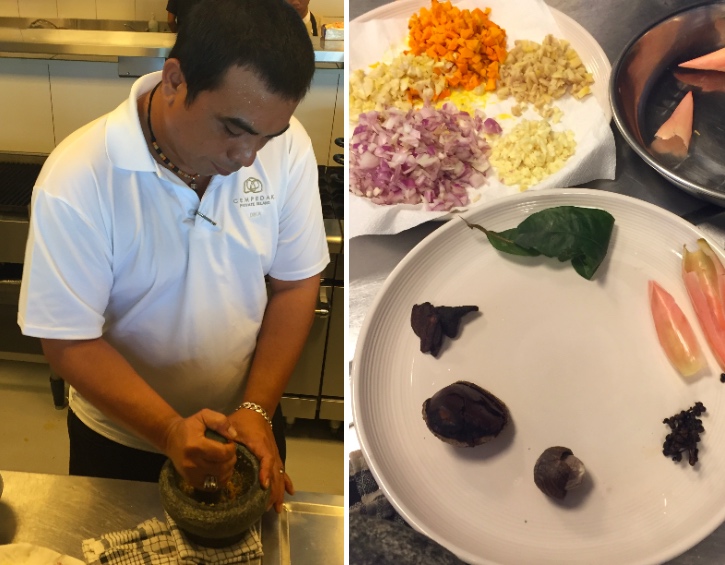
Join Foodie Mama Ghillie on her Indonesian cooking journey!
Who better to learn from about the secrets of Indonesian cooking than Pak Dika, the executive Chef of not one but two of Indonesia’s sustainable island resorts – family friendly Nikoi and its grown-ups-only sister island, Cempedak (read our review here). Situated just off the coast of Bintan, like these travel destinations, there’s no flying required from Singapore! Chatting to the master and taking part in a fabulous cooking class, Ghillie James learnt the secrets of Satay, how to perfect a coconut fish curry and the key ingredients to make Nasi Goreng the best you’ve ever tasted!

Indonesia is the fifth largest country in the world. It is an archipelago consisting of 18,000 islands, spanning one-eighth of the globe and is occupied by 250 ethnic groups. Ethnic diversity coupled with cultural influence is what makes Indonesia such a joy for the culinary adventurer, as its foods are so varied and intriguing. And at its culinary core are spices! From cinnamon to turmeric, cloves to ginger the colour, warmth and richness of Indonesian cooking comes from the many spices used in its preparation from the roots to the tips. Spices have long been used for their healing and nutritional properties too and the dishes prepared on the islands sing good health and wellbeing not only because of the spices they typically contain but also the many locally sourced fresh ingredients included.

More and more of the fresh ingredients used in Pak Dika’s menus are being sourced locally and from the islands themselves. Cempedak and Nikoi’s nature expert Boyan, gave real insight into the island’s flora and fauna used both in the construction of the resorts and the food (he told me that when they first started to build on the uninhabited island the project manager and his team slept in tents until the first bamboo buildings had been constructed!). The island has existing lemongrass, pandan, tamarind and belinjau (in Bahasa called melinjo – the young leaves used in curries and for a spicy sour soup) as well as local basil, roselle, mulberries and passionfruit. When we visited the beginnings of a vegetable patch had been started. Their objective is to make the islands as self sufficient as possible – eventually producing their own vegetables, fruit and herbs.

Indonesia born Pak Dika has been working for the founders of Nikoi and Cempedak since the start. Originally from Medan (north Sumatra), he helped his mum as a kid, crushing cassava, stirring the pot and watching. She was a great cook, making his Batak tribe’s recipes. Recipes such as tuna naneura, which he made for me to try. It is marinated fish ceviche-style in kaffir lime juice and zest. It is then rubbed with a subtle spice paste 2 hours before serving. The result – absolutely incredible! He also made the popular Nasi Goreng (country fried rice), served in Indonesian homes rather like an all day breakfast! Then came my hands on cooking class. These classes aren’t advertised, but any guest can ask to do a class at Cempedak or Nikoi (organise prior to your arrival), and I highly recommend it for both adults and children. The combination of nature walk and cooking class is ideal as families can learn about local flora and fauna, growing fruits and veggies from seed and learn to cook healthy Indonesian food, using local ingredients. We loved our experience!
Recipes (adapted slightly to make it easier to recreate in Singapore homes!)
Nasi Goreng
This has become a favourite in our house! The subtle additions of a splash of soy, a spoonful of oyster sauce and even a small dollop of ketchup really transform the rice. Feel free to make it with chicken, prawn or even bacon.
Serves 2-3
2 tbsp mild oil
150g chicken thigh meat, chopped
2 cloves garlic, chopped
2 shallots or ½ onion, thinly sliced
½ carrot, very finely chopped
a handful brocolli, broken into small florets
1 green chilli, chopped
½ tsp shrimp paste (optional)
1 egg, beaten and 2 eggs for frying
3 cups cooked and chilled jasmine rice
2 tsp sweet soy
2 tsp light soy
1 tbsp oyster sauce
2 tsp ketchup
a handful shredded pak choy, sliced sugar snaps or beansprouts
Directions:
In a wok preheat the cooking oil, and sauté the chicken until browned. Add the garlic, shallot or onion, carrot and broccoli, chili and shrimp paste (if using) and stir over the heat for 2-3 minutes. Add the beaten egg continue to stir-fry for a few seconds, then add the rice. Using a metal spoon or fish slice, turn the rice over in the wok, adding the sweet soy, light soy, oyster sauce and ketchup. Mix together until the rice is the same colour and has a good smell. Add the pak choy, sugar snaps or bean sprouts and season with a pinch of salt and some pepper. Taste, adding extra flavouring if required, then serve onto plates and top each with an egg cooked sunny side up.
Note: you can serve with a small dish of “sambal belacan” on the side.
Red Fish curry
There can be a basic white curry, yellow curry containing turmeric, or the addition of chilli, transforming it to a deep exciting ochre colour.
Serves 2-3
For the paste:
2-inch piece fresh turmeric, peeled
1 inch ginger, peeled
½ inch piece galangal, peeled
1 ½ tbsp whole dried chillies (soak in boiling water for 15 minutes then drain)
4 cloves garlic, peeled
5 small shallots, peeled
2 tbsp mild oil
For the curry sauce:
1 stalk lemongrass, finely sliced
1 bay leaf
2 kafir lime leaves, shredded
½ inch cinnamon stick
4 cardamon pods
2-4 birds eye chillies, chopped
300ml coconut milk
600g snapper fillet de-skinned and cut into cubes
1/2 tomato, cut into thin wedges
salt and sugar to taste
squeeze of lime juice
Directions: Grind the spice paste ingredients in a pestle and mortar or food processor if making a larger quantity. The oil can either be added to the processor or at the end of pounding in the pestle. It should be finely chopped and all same size. Over a medium heat heat the oil (if you haven’t added it to the processor) in a saucepan or wok and saute the paste until fragrant.
Add lemon grass, bay leaf, lime kaffir leaf, cinnamon stick and cardamon. Add a splash of water and the coconut milk and a sprinkle of birds eye chilli (as much as you dare!). Then bring to a gentle boil, stirring occasionally to avoid the coconut milk from splitting, and cook for ten minutes or so (adding more water if needed) until the mixture has thickened slightly and tastes cooked. Add fish and continue until the fish is cooked. Add the tomato, season with salt and sugar and taste, adjusting seasoning accordingly and adding a squeeze of lime if needed. Serve with rice.

Chicken Satay
A family favourite, these skewers make a delicious substantial starter or can be served with rice and salad for a barbecue lunch or dinner.
Makes 6 large or 12 smaller skewers
For the satay sauce:
2 cloves garlic, peeled and roughly chopped
2 shallots, peeled and roughly chopped
½ inch galangal, peeled and roughly chopped
1 birds eye red chilli, deseeded and sliced
1 tbsp palm sugar
1 x 1 cm strip kaffir lime zest or normal lime zest, shredded
2 tsp tamarind juice
100g unsalted roasted peanuts (or you can fry unroasted peanuts till brown in some oil)
2-3 tsp sweet soy sauce
150-250ml water
For the chicken satay sticks:
1 clove garlic, roughly chopped
2 small shallots, peeled and chopped
2cm fresh ginger, peeled and chopped
1cm turmeric, peeled and chopped
1 birds eye red chilli, deseeded and chopped
½ tsp coriander seeds or 1/3 tsp ground coriander
1 kafir lime leaf, shredded
1 stalk lemongrass, sliced
2 tbsp oil
3-4 large chicken breasts, skinless, cut into slices
½ lime, juice
wooden satay sticks, soaked in water.
Directions: For the satay sticks, grind together or process in a mini chopper the garlic, shallots, ginger, turmeric, coriander seeds, lime leaf, lemongrass, red chilli (and oil/lime if processing). The mixture needs to be pounded until the paste is evenly ground. Add the chicken (and oil and lime juice if you have ground paste in pestle and mortar), and a little salt. Cover and leave for 30 minutes, or overnight to marinade. Then thread on to pre soaked wooden kebab sticks.
For the sauce, in a mini processor (or a mortar), grind together the garlic, shallot, galangal and chilli, lime zest and peanuts. Continue to grind until the peanuts are crushed. Put into a saucepan, add the tamarind and palm sugar and the first 150ml water and bring to the boil, stirring. Add a spoonful of sweet soy and season with a little salt. Continue to simmer until the sauce has darkened and thickened, then taste again, adding more water, soy or salt as needed. Set aside, and reheat as needed.
Griddle or barbecue the skewers for 6-8 minutes or until the chicken is cooked through. Serve with the satay sauce.






 View All
View All





 View All
View All











 View All
View All






